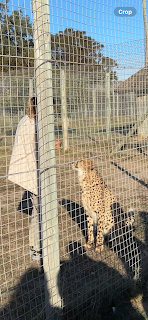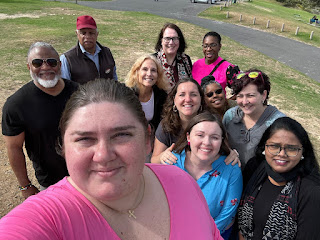Today is our 5th full day in South Africa and we've covered a lot of ground! We've done some touristy things as you can see in photos below. But we've also done a great deal of learning about South Africa --- the country's ancient history, its people, its languages, its more recent history of apartheid, its animals, and its ability to reconcile, converse, and pursue dignity for all people. We are staying in the West Cape so we're only seeing a small part of the country but we've met folks from all over. We're here with UPSem's Assistant Professor of Theology and Ethics and Director of the Master of Arts in Public Theology Program who is a South African feminist scholar. She is our guide alongside our tour guide, Ronald, who cared for us all week, and UPSem's Associate Professor of Bible and Director of the Center for Social Justice and Reconciliation. In addition to our two professors and tour guide, there are 8 students. We're all women and a mix students in the Master of Divinity, Master in Public Theology, Master in Christian Education, and Doctor of Ministry programs.
Below are photos from the week with reflections listed below some of the photos.
Day 1
We got settled in our hotel and neighborhood and enjoyed the hotel's complimentary breakfast. Then, we headed out for a driving tour of the Stellenbosch area, which included a wine tour. Stellenbosch is known for a climate similar to Napa Valley, thus there are countless wineries. After a quick wine tour, we visited Cheetah Outreach, which is an organization that provides rehabilitation for cheetahs and other animals in addition to doing educational and conservation work. Our group loved learning from the employee who explained her relationships with each cheetah who lives at Cheetah Outreach and taught us about the beautiful, wild creatures. Day 1 was the perfect way to start our time in South Africa and included plenty of rest to help us get over the jetlag.
Day 2
We rode in the van and passed through Khayelitsha, which is a Black township outside of the major city of Cape Town. Khayelitsha is known as a "shanty town" and consists of thousands of homes that are made from scrap materials. The homes look more like what we might call "shacks" in the USA. As we drove past the township, our tour guide and professor talked to us about the effects of not just apartheid but also poverty and racism more broadly. 5 million people live in Cape Town and that number includes 1 million people who live in Khayelitsha. We discussed the impacts of government, economy, lack of affordable housing, and racism.
The drive took us to Table Mountain National Park where we visited Cape Point and Cape of Good Hope, which are the Southwestern-most points of Africa. I hiked up to the top of Cape Point and had an incredible view of the point where the Indian Ocean and Atlantic Ocean meet each other. During our visit to Cape Point, we ran into a baboon along the side of the road! Then we headed to an area of Cape Town that's known for its penguins. We spent time watching the penguins and were in awe that we could be that close to them.
At the end of the day, we spent time together and engaged in group processing. We had tough conversations about how the day's experiences impacted each of us. We discussed liberation vs. equality, apartheid and its affect on South Africa but also the economy of the nation, and what we're observing and learning here and how we take that back home with us.
Day 3
We began our day at the District 6 Museum in Cape Town. District 6 was a thriving interracial community in Cape Town up until 1966 when the apartheid government of South Africa announced that they would force everyone out of the accessible, loving, diverse, and close-knit neighborhood of District 6 (they forced them to move out of their homes and used military vehicles to move them) to areas further from the city center where they were divided by the color of their skin (click here for information about how the apartheid government classified people). Not only were people forced to move further away but all non-white people were forced to move from places with views of the ocean, access to the mountains, and gorgeous views to places tucked behind the mountains and in areas with no pretty views. The neighbors of District 6 had been living together for decades when suddenly their own government forced them out. Today, the District 6 Museum is inside of a former-Methodist Church in District 6. District 6 sits mostly empty because even though the government forced everyone to move out, no private white people felt they could purchase land in District 6.
These are the street signs from the District 6 neighborhood.
This is our group with our tour guide, Ronald, at the District 6 Museum. We had a private tour of the museum from a woman who grew up in District 6 and was a teenager when her family was forced to move out of the neighborhood.
These tiles are people's stories that they wrote and they are now part of the floor at the District 6 Museum.
This room serves as a memorial to District 6 in hopes that a memorial will one day be constructed outside of the church building in the main area of District 6.
This plaque is mounted on the outside of the District 6 Museum and has been there for at least 40 years. The plaque was added to the building when it was the Methodist church in District 6 and it was the first monument to honor people impacted by apartheid in the country of South Africa.
The minister of the Methodist church at the time when this plaque was placed was Rev. Dr. Peter Storey. Dr. Storey is a South African Methodist minister, the former president of the Methodist Church of Southern Africa (MCSA), and of the South African Council of Churches (SACC), and a Professor Emeritus of the Practice of Christian Ministry at Duke University Divinity School. Dr. Storey was the minister at the Methodist church in the loving, diverse District 6 when the apartheid government announced their plans for forced displacement of all people living in District 6.
Our group had the pleasure to meet with Dr. Storey on the 4th day of our trip which is when he preached to us over dinner --- really, it was just a conversation. But, it was a prophetic conversation and one which I am continuing to process. I'll post more on that later but you can purchase his memoir here if you're interested in learning more about this incredible man.
We ended our day in Cape Town by visiting the Bo-Kaap neighborhood, which is formerly known as the Malay Quarter. It's a former racially segregated area and is a historical center of Cape Malay culture in Cape Town. Bo-Kaap is known for its brightly colored homes and cobblestoned streets. The area is traditionally a multicultural neighborhood, and 56.9% of its population identify as Muslim. Bo-Kaap has brightly colored houses, which signify an expression of freedom by the new homeowners because all the houses were painted white while on lease.
Day 4
Our first stop of the day was Table Mountain, which is located within Table Mountain National Park in Cape Town (we visited the opposite side of the national park on day 2 when we went to Cape Point). We took a cable car up the mountain, took photos quickly, and went right back down the mountain because we had to make it to the next item on our agenda, which was a ferry ride to Robben Island.
We took the ferry, via the Nelson Mandela Gateway, to Robben Island. Robben Island is a World Heritage Site. Robben Island is where Nelson Mandela, Robert Sobukwe, and dozens of other political prisoners were held for years during the apartheid government. We toured the island and learned about the conditions of the prison for the political protesters of the apartheid government. It was a powerful experience that made me curious about our prisons in the USA. Ministry with folks who are imprisoned is something about which I'd like to learn more.
We had the BEST end to our day at dinner with Dr. Peter Storey. As I wrote in the day 3 post, I am still gathering my notes from our conversation with Dr. Storey. I'll ruminate on those and put together a separate post (or maybe a sermon!) at some point. I felt God's Spirit moving among us and felt God calling me to more immediate action as a member of a mainline church in the USA. Dr. Storey is the embodiment of public theology and prophetic protesting and proclamation/preaching.
Day 5
Today was a slower day than the last 4 days. We only visited one place and it was the Langa township, which is the first Black township in South Africa. We had a local guide who taught us about the history of Langa and the surrounding "mixed race/colored" townships. We supported the local economy by purchasing all sorts of souvenirs and artwork from local artists!
I find myself constantly thinking about the USA and our big cities, and even small ones, that are often still segregated like many of our churches, because of intentional things like urbanization and gentrification which South Africa has experienced, too.
Today marked the end of our tours around the West Cape, South Africa. For the next week we'll be staying in the university area (besides when we go to church in Cape Town on Sunday) because we have class and meetings from Monday-Thursday of this coming week. I'll spend tomorrow doing the last of my homework for class and journaling some more about my learnings on this trip so far. I'm grateful for UPSem and the opportunity to travel to South Africa where we're able to learn about and experience public theology.
Blessings to each of you from the complex, reconciling, and beautiful country of South Africa. Email me if you have any questions, thoughts, concerns, or anything that you'd like me to check out for you while I'm here.
Peace,
Caitlin







.jpg)












No comments:
Post a Comment